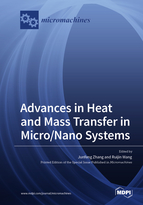Advances in Heat and Mass Transfer in Micro/Nano Systems
A special issue of Micromachines (ISSN 2072-666X). This special issue belongs to the section "E:Engineering and Technology".
Deadline for manuscript submissions: closed (25 May 2022) | Viewed by 30347
Special Issue Editors
Interests: microfluidics; nanofluids; heat and mass transfer; porous and particulate flows; red blood cell dynamics; lattice Boltzmann method; numerical model development
Special Issue Information
Dear Colleagues,
The trend toward the miniaturization of components in mechanical and electronic equipment has been the driving force for the fast development of micro/nano-systems. Heat and mass transfer are crucial processes in such systems, and they have attracted great interest in recent years. Tremendous effort of in terms of theoretical analyses, experimental measurements, numerical simulations and practical applications has been devoted to improve our understanding of the complex heat and mass transfer processes and behaviors in such micro/nano-systems. This Special Issue of Micromachines, “Heat and Mass Transfer in Micro- & Nano-Systems”, is dedicated to showcase recent advances in heat and mass transfer in micro- & nano-systems, with particular focus on the development of new model and theory, the employment of new experimental techniques, the adoption of new computational methods, and the design of novel micro/nano-devices.
Dr. Junfeng Zhang
Prof. Dr. Ruijin Wang
Guest Editors
Manuscript Submission Information
Manuscripts should be submitted online at www.mdpi.com by registering and logging in to this website. Once you are registered, click here to go to the submission form. Manuscripts can be submitted until the deadline. All submissions that pass pre-check are peer-reviewed. Accepted papers will be published continuously in the journal (as soon as accepted) and will be listed together on the special issue website. Research articles, review articles as well as short communications are invited. For planned papers, a title and short abstract (about 100 words) can be sent to the Editorial Office for announcement on this website.
Submitted manuscripts should not have been published previously, nor be under consideration for publication elsewhere (except conference proceedings papers). All manuscripts are thoroughly refereed through a single-blind peer-review process. A guide for authors and other relevant information for submission of manuscripts is available on the Instructions for Authors page. Micromachines is an international peer-reviewed open access monthly journal published by MDPI.
Please visit the Instructions for Authors page before submitting a manuscript. The Article Processing Charge (APC) for publication in this open access journal is 2600 CHF (Swiss Francs). Submitted papers should be well formatted and use good English. Authors may use MDPI's English editing service prior to publication or during author revisions.
Keywords
- Nanofluidics & Nanofluidics
- Heat and Mass Transfer
- MEMS
- Micro- & Nano Devices and Sensors
- Nanofluids
- Multiphase Flows








